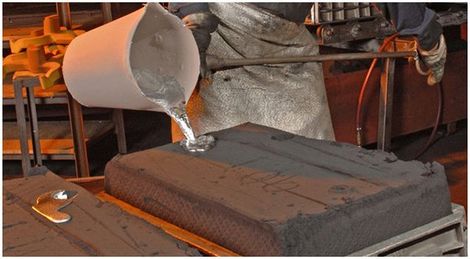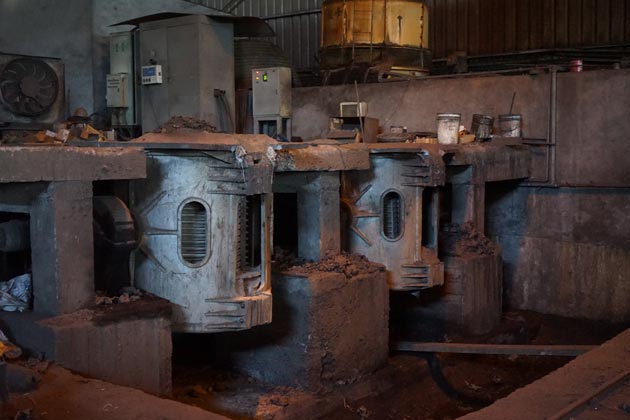Introducing the Intricacies of Layout and Manufacturing at a Metal Foundry
The design and manufacturing procedures at a metal foundry include a collection of elaborate steps. Each phase, from picking raw products to melting and spreading, plays a crucial duty in the end product. Aluminum Foundry. Precision and high quality control are paramount in this market. As modern technology advancements, brand-new developments are emerging. These growths may redefine conventional methods. What effects do these modifications hold for the future of metal foundries?
The Melting Process: Transforming Raw Materials Into Liquid Metal
The melting process works as the vital primary step in changing resources into liquid metal, a treatment vital for foundry operations. This stage starts with the cautious option of steels, which may consist of iron, light weight aluminum, or copper, depending on the desired end product. Each material is assessed for purity and composition to ensure suitable melting problems.

As the steels reach their melting point, they convert from strong to fluid, permitting further refinement. This process can additionally consist of the removal of contaminations via slag formation, assuring the high quality of the liquid metal. Ultimately, the successful completion of the melting procedure lays the foundation for succeeding metalworking operations.
Molding Techniques: Forming Metal With Accuracy
Complying with the melting procedure, the next phase in metal foundry operations includes molding techniques that form the fluid metal into desired forms. Various approaches are used, each picked based on the particular demands of the project. Sand casting, among the most typical techniques, makes use of a blend of sand and binder to produce molds that can be quickly formed and recycled. Another method, financial investment casting, involves producing a wax pattern that is covered in a ceramic covering, permitting detailed designs and high precision.
Die spreading, on the other hand, utilizes high-pressure to infuse molten steel right into steel mold and mildews, causing resilient and consistent items. Furthermore, the selection of molding technique influences the cooling rate, surface finish, and dimensional accuracy of the end product. Consequently, recognizing these techniques is vital for enhancing layout and making sure the successful production of metal parts customized to details applications.
Casting Techniques: From Model to Manufacturing
Many casting approaches are used in steel factories to change from prototype growth to major manufacturing. Amongst these methods, sand spreading stands out for its adaptability and cost-effectiveness, making it ideal for both small and large production runs. Investment spreading, understood for its accuracy, is commonly made use of for complex geometries, permitting for great information in the last item. Die spreading, suitable for high-volume manufacturing, uses liquified metal injected into molds, offering outstanding surface area finish and dimensional accuracy.

Top Quality Control: Making Certain Quality in Every Pour
While the casting process can differ considerably between approaches, maintaining strenuous quality assurance is vital to ascertain that every pour fulfills the called for criteria. Quality control in a metal foundry encompasses a series of systematic checks and examinations created to determine issues early in the production procedure. This consists of thorough evaluations of resources, tracking of melting temperature levels, and assessments of mold and mildew stability.
Foundry employees employ different testing strategies, such as non-destructive testing and dimensional verification, to determine that castings accomplish wanted requirements. Furthermore, adherence to developed industry standards and certifications enhances the dependability of the final item.
Feedback loopholes are also crucial; any type of discrepancies noted news during quality evaluations are assessed to refine procedures and reduce future errors. Ultimately, a culture of quality control fosters not just customer contentment websites but also a track record for quality in the competitive landscape of steel manufacturing.
Advancements and Technologies: The Future of Metal Foundries
The landscape of metal foundries is swiftly developing, driven by developments in technology and ingenious practices. Automation and robotics are transforming traditional operations, improving performance and precision during manufacturing. Automated pouring systems and robot arms decrease human mistake, causing better results. Additionally, the combination of artificial intelligence is enabling anticipating upkeep, optimizing tools efficiency, and reducing downtime.
Additive manufacturing is arising as a game-changer, enabling quick prototyping and the production of intricate geometries that were formerly unattainable. This technology helps with the personalization of steel components, dealing with particular client demands without considerable time hold-ups.
Sustainability is likewise a vital emphasis, with factories taking on greener practices, such as reusing scrap metal and utilizing energy-efficient heating systems. These technologies not only improve productivity yet also align with global efforts towards ecologically accountable manufacturing, making sure the future of steel factories stays competitive and robust in an altering commercial landscape.
Frequently Asked Questions
What Sorts of Metals Are Commonly Made Use Of in Foundries?
Typical steels utilized in foundries include light weight aluminum, cast iron, brass, bronze, and steel (Aluminum Foundry). Each metal has unique residential or commercial properties, making them ideal for various applications in industries like automobile, aerospace, and building and construction, to name a few
Just How Do Shops Handle Waste and Environmental Influence?
Shops manage waste and environmental influence by applying reusing programs, utilizing sophisticated purification systems, and sticking to strict governing standards. They usually purchase lasting innovations to decrease emissions and promote accountable resource usage throughout their operations.
What Precaution Are in Area for Workers?
Shops implement numerous safety actions for employees, including individual protective equipment, correct ventilation systems, normal safety and security training, emergency action methods, and rigid adherence to job-related wellness regulations to lessen risks related to unsafe materials and devices.
How much time Does the Entire Manufacturing Process Commonly Take?
The entire production process commonly takes several weeks, depending on the intricacy of the style and the products used. Aspects such as mold and mildew preparation, melting, and cooling time considerably influence the overall duration of manufacturing.
What Are the Key Challenges Encountered by Metal Factories Today?
Metal factories today encounter difficulties such as increasing product costs, fluctuating need, environmental regulations, proficient labor shortages, and keeping top quality control. These problems complicate manufacturing performance and success in a progressively affordable market.
The design and manufacturing procedures at a metal foundry include a collection of detailed steps. The melting process offers as the critical initial action in transforming raw products into fluid metal, a procedure essential for foundry operations. Following the melting procedure, the following phase in metal find more information foundry procedures includes molding strategies that shape the fluid steel right into desired kinds. Various casting approaches are used in metal shops to change from model growth to full-scale production. Quality control in a metal foundry includes a collection of organized checks and analyses designed to identify issues early in the manufacturing procedure.